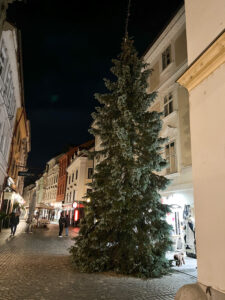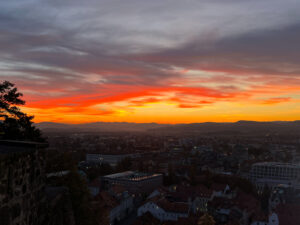 When I arrived in Slovenia, I wasn’t doing very well. The headache that had been building for days near the end of my stay in Croatia had only gotten worse. My eyes ached, and I was exhausted. And to make matters worse, my phone had stopped working. I had no cell service or data until right before departing Croatia on my 5:00pm bus. The situation could have been far worse. I knew my way around town and where the bus station was, and I had a screenshot of my bus ticket saved in my photos (always take a screenshot the second you buy any ticket, travelers!), so I wasn’t relying on the phone for anything. But still, I knew that my parents and Michael would worry if they tried to contact me and couldn’t, and I worried that I wouldn’t figure out how to get the phone working again. Finally, I ended up finding enough Wifi that I could message Michael for help. (It ended up being an issue with the VPN, and the phone was fine after I turned the VPN off.) It felt good to know that I would have been fine if I’d had to carry on for a while without a working phone, but it also felt disconcerting to recognize how fully I relied on the phone every day. We’ve created remarkable tools and then enslaved ourselves to them.
When I arrived in Slovenia, I wasn’t doing very well. The headache that had been building for days near the end of my stay in Croatia had only gotten worse. My eyes ached, and I was exhausted. And to make matters worse, my phone had stopped working. I had no cell service or data until right before departing Croatia on my 5:00pm bus. The situation could have been far worse. I knew my way around town and where the bus station was, and I had a screenshot of my bus ticket saved in my photos (always take a screenshot the second you buy any ticket, travelers!), so I wasn’t relying on the phone for anything. But still, I knew that my parents and Michael would worry if they tried to contact me and couldn’t, and I worried that I wouldn’t figure out how to get the phone working again. Finally, I ended up finding enough Wifi that I could message Michael for help. (It ended up being an issue with the VPN, and the phone was fine after I turned the VPN off.) It felt good to know that I would have been fine if I’d had to carry on for a while without a working phone, but it also felt disconcerting to recognize how fully I relied on the phone every day. We’ve created remarkable tools and then enslaved ourselves to them.
Typically, any one of these things might cause me to panic, but on the way to Slovenia, I was too tired to panic. Everything felt a bit like a dream. We drove up the coast through Trieste and then headed into the foothills of Slovenia. We arrived in Ljubljana, the capital (pronounced loo-blee-ah-nuh), around 9:00pm, and I was very glad that I’d splurged on a private room for my stay.


Of all the hostels I stayed in on my trip, Hostel Celica was one of a handful I was most excited about. It was originally a military prison for over 100 years, dating back to when the Austro-Hungarian army built a military base in the area and up until Slovenia became an independent country in 1991. It was converted into a hostel in 2003 and then renovated in 2018. Each of the private rooms in the hostel is a former prison cell. I’d imagined that just knowing the place had been a prison would give it a creepy vibe, but it couldn’t have felt less creepy. (Or nothing was creepy except the two isolation cells they keep intact in the basement specifically for creeping out guests who dare to venture down the stairs. Which is to say, me.) Instead, it’s turned into an artistic hub for designers and musicians. While I was staying there, there was a black-tie event full of wine and jazz music and glamorous people, and this felt like the general vibe of the place.
The most remarkable thing about the hostel is the design of the private cell-rooms. Well-known designers were picked to design each different cell. They were all given the same budget and the same-sized room, but they had free reign over how they chose to design them. The result is 20 totally unique rooms that look like works of art. I did a hostel tour during my stay, and I ended up being the only person on the tour, so it turned into an informal chance for the staff to show me every private cell-room that wasn’t occupied. One room was designed with all local wood and materials. One room was designed to look like it would have looked when it was a prison cell. One room (the most popular) has a giant, circular, loft bed and blue walls that I imagine make you feel as though you’re sleeping in the sky. My room was sleek and modern with a double lofted bed that I had to climb a wooden ladder to reach. The room has prison bars in addition to the regular door for added aesthetic. Each private room costs between $40 and $50. There are also shared dorm rooms in the hostel for a more budget friendly option, but I had my heart set on staying in a cell. I decided I deserved this splurge because the next day was my birthday.
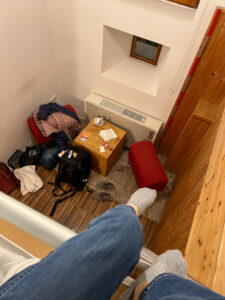
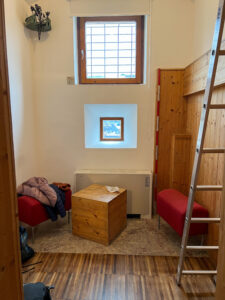
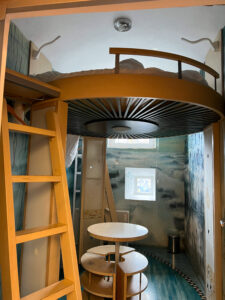

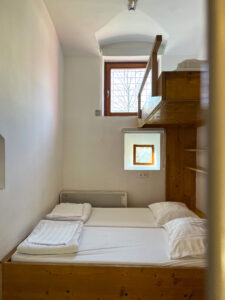
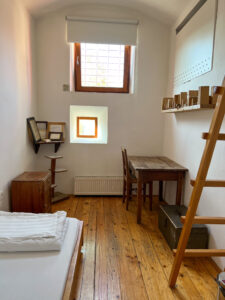
I arrived late, ordered delivery, went straight to bed, and woke up feeling a little better in the morning. It was my 33rd birthday. I’ve spent many birthdays away from family and friends, and I’m not a person who makes a big production of birthdays anyway, but this was the first birthday I was spending across the ocean without knowing a soul. Rather than feeling any sadness about this, I felt like it was a great excuse to splurge on anything I wanted to do.
I spent the morning doing a free walking tour where I learned all about the history of Ljubljana and Slovenia. Though all of the former Yugoslavian countries have distinct personalities, Slovenia felt nothing like the rest of them. It’s a hard country to classify, because even though it was part of Yugoslavia and typically included in Balkan itineraries, it’s not technically on the Balkan peninsula. The Julian Alps (a range of mountains that are part of the Eastern Alps) run through Slovenia, and the climate feels northern Italy or Austria. Though the Yugoslav Wars were a violent and bloody nightmare that spanned years in some Balkan countries, Slovenia emerged as an independent country almost entirely unscathed. It was the first Yugoslavian country to declare independence (in 1991), and the conflict that resulted lasted just ten days. Today it’s referred to as the Ten-Day War or the Slovenian War of Independence, but even the term “war” feels like an exaggeration. Unlike most of Yugoslavia, Slovenia was considered “ethnically homogenous,” and therefore the Yugoslav People’s Army weren’t interested enough in the conflict to waste resources on it. Their focus at first was on Croatia where there was greater territorial interest. Only about 20 Slovenian people died in the war.
Today, it feels like Slovenia has never known a time that wasn’t peaceful. In Ljubljana, their statues are of poets, dragons, and mythical creatures instead of political leaders or war heroes, and I think this says a lot about what kind of place Slovenia is. Our tour guide told us that the prime minister was frequently seen shopping in the downtown farmer’s market. (Back home, it would be a high security risk for a president to step foot on a public sidewalk without a security team.) In Slovenia, they value the arts and literature over power, and Ljubljana is the most environmentally conscious city I’ve ever visited. I read that over 80% of waste is recycled in Ljubljana—it’s bizarre how clean it is. If a more quaint and peaceful capital city exists, I haven’t seen it.
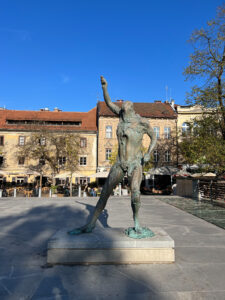
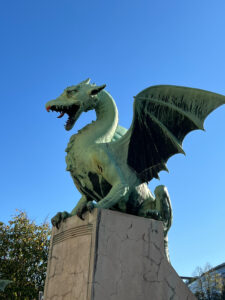
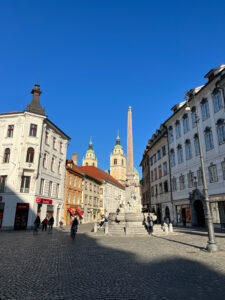
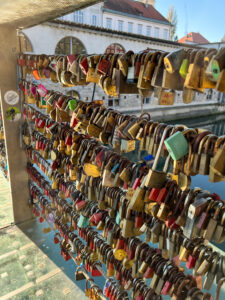
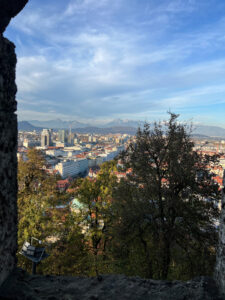

For my birthday, I got a mini Slovenian cake that my tour guide recommended, and then I found a chocolate shop and got some local chocolate. I climbed up the hill to the castle that overlooks Ljubljana. Instead of featuring war weapons like most castles, this one had a puppetry museum, a photography exhibit, and a jazz club. I climbed the castle’s tower for the view, and I got such bad vertigo on the way up the tiny, spiraling staircase that strangers asked me if I was alright. Oh, don’t mind me, I’m just scared of heights, I said. The strangers were kind enough to take a photo of me once I reached the top so that I had proof I’d done it before I sprinted back down to safety. I watched the sun set over the distant Alps from the viewing point on the hilltop.
Downtown, I treated myself to a birthday dinner of gnocchi with mushrooms and truffles—my first time tasting truffles—at a nice restaurant. It was one of the best meals of my entire trip, and I ate so much I had to waddle to my next stop—another restaurant the tour guide recommended for yet another piece of cake. I wholeheartedly recommend this birthday itinerary—constant cake/chocolate, views of the Alps, castle-climbing, and an unforgettable feast.

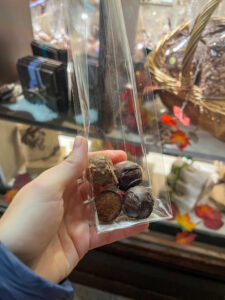
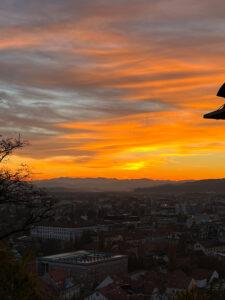
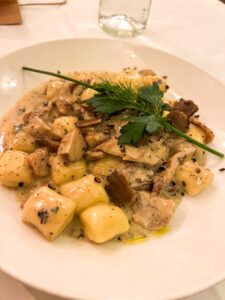

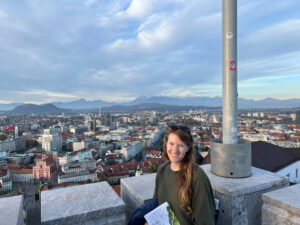
The next morning, I woke up with swollen lymph nodes and nearly panicked. After asking my mom to Google whether or not I was dying, I decided that making a day trip to Bled wouldn’t make me worse. I caught an hour-long bus to the tiny town of Bled, famous for its lake and castle views. The town itself was nearly empty. I’ve heard the town is bustling and adorable in the high season, but I really wouldn’t recommend staying in Bled in November unless you’re there only for solitude and nature. But I would 100% recommend visiting in November for a day trip. I felt like I had the town almost to myself. I climbed to the top of the castle (In the true Slovenian spirit, this one had a printing press and an endless supply of Slovenian cream cake which of course I ate.) to see the view. Then I took the long walk around the entire lake. Slovenia is quiet about its beauty, so it takes you by surprise over and over again.
The bus station in Bled wasn’t open, so I had to wait and hope that a bus would pick me up eventually and take me back to Ljubljana. (It did.) Back in Old Town Ljubljana, the town had put a giant Christmas tree up overnight. It was the first sign of the coming Christmas season.
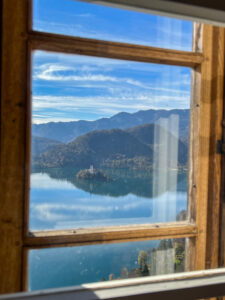
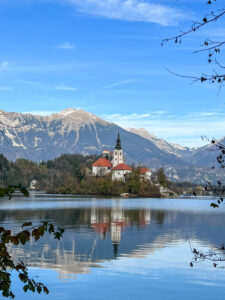




Three nights in Slovenia was not enough. Ljubljana and Bled are the two main tourist hubs of the country, but there are many smaller towns that don’t get a lot of visitors that I hope desperately to go back and visit. The next day, my lymph nodes and the rest of me were already better. The headache was gone, and I felt almost back to normal again after weeks of being sick. If you’re very ill, I recommend excessive chocolate/cake, Slovenian truffles, Alpine air, more water than you think you can consume, a lot of prayers, an abundance of Tylenol, and whatever magical properties Ljubljana emanates. I got on a bus that morning heading toward Italy.


